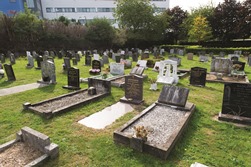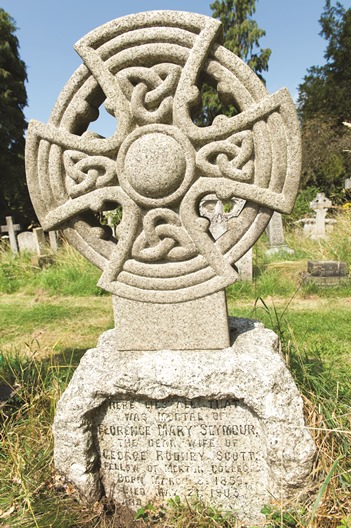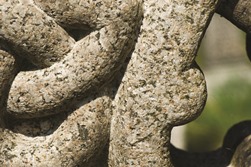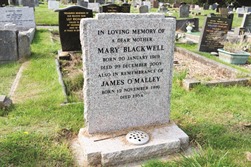Fieldwork can be made to come alive in the unlikely but convenient surroundings of city centre cemeteries, says Nina Morgan
 Fieldwork is expensive, difficult to arrange, requiring extra effort and dedication on the part of teaching staff – and given the availability of computers and satellite imagery to illustrate geology virtually anywhere in the world – ultimately, some would argue, unnecessary. These are just a few of the arguments used to justify reducing, or even eliminating, the requirement for geology students to experience life in the field.
Fieldwork is expensive, difficult to arrange, requiring extra effort and dedication on the part of teaching staff – and given the availability of computers and satellite imagery to illustrate geology virtually anywhere in the world – ultimately, some would argue, unnecessary. These are just a few of the arguments used to justify reducing, or even eliminating, the requirement for geology students to experience life in the field.
Caption: General view of gravestones in Headington Municipal Cemetery in Oxford.
Many practising geologists – especially those aged over 40 – will readily admit that the opportunity to study and do fieldwork in the great outdoors was one of the factors that drew them to study geology in the first place. But, as Jonathan Paul argued in his Soapbox article Adapt or Die! (Geoscientist April 2014) fieldwork opportunities no longer serve as a draw for geology students today.
"Many students nowadays," Paul notes, "do not find the prospect of fieldwork attractive, equating it with manual labour and preferring to stay at home. The folly of using fieldwork as a bait [to recruit geology undergraduates] becomes clearer when we consider the ubiquity of computers in most professional geoscience jobs."
 Paul's article sparked off a vociferous and often heated debate in defence of fieldwork that has raged in this magazine’s Soapbox section and Letters pages ever since (see for example, Mike Streule and Lorraine Craig (Soapbox, Geoscientist 25.1 February 2015) and Mike Harris (Soapbox Geoscientist 6 July 2015)). The arguments for the value of fieldwork were neatly summarised in a letter from Willie Towers, published in Geoscientist Online in May 2014:
Paul's article sparked off a vociferous and often heated debate in defence of fieldwork that has raged in this magazine’s Soapbox section and Letters pages ever since (see for example, Mike Streule and Lorraine Craig (Soapbox, Geoscientist 25.1 February 2015) and Mike Harris (Soapbox Geoscientist 6 July 2015)). The arguments for the value of fieldwork were neatly summarised in a letter from Willie Towers, published in Geoscientist Online in May 2014:
"Rocks do not occur in computers, GIS or 3D visualisation models but out there in the real world. If geology does not continue to teach basic field observation and mapping skills, it will slowly die. Geoscientists, whether they choose academia or industry careers or somewhere in the middle, need the basic grounding in the basic disciplines of petrology, sedimentology and palaeontology to name but three... I value the processing power of new technologies, but we must have the grounding to interpret what they are actually telling us."
Urban geology
Caption: This Celtic cross located in Holywell Cemetery in Oxford is a monument to Florence Mary Seymour Scott, author of a number of novels published in the late 19th and early 20th Centuries. It is composed of two types of granite. The Celtic cross itself is a medium-coarse grained granite with a slight foliation (closeup below). Rich in quartz, plagioclase and mica (thus alumina-rich) is probably an S-type granite derived from a sedimentary protolith. It may have come from Galway, Ireland. The plinth, in contrast, is composed of a coarse granite with large plagioclase crystals up to 7.5cm long which probably came from Cornwall.
Although, admittedly not a substitute for fieldwork in exotic locations like the Himalayas, the California deserts or even the Scottish Highlands, the growing field of urban geology – the geology of the built environment – provides one solution for overcoming the expense and difficulties of introducing to students to the principles of geology fieldwork. Championed by geologists at University College London (UCL) including, initially, Eric Robinson and now Ruth Siddall and her colleagues, urban geology is based on the idea that the town centres and burial grounds can serve as extensive outdoor museums – free to access, open to all, and ripe for introducing geology to the world at large.
“The urban geologist is exposed to an enormous variety of rock types - far more than the committed field geologist could ever see in outcrop in the field," writes Siddall on her website (www.ucl.ac.uk/~ucfbrxs/Homepage/UrbanGeology.htm). Although she admits that there is no substitute for exploring rocks in situ to obtain an understanding of the three-dimensional geometries of outcrops, there is, she says “much [that] can be learned about petrography, petrology, palaeontology and the environment of formation of many rocks on the average High Street.”
Burial treasure
 The same can be said about the average urban cemetery – a 'field area' often promoted by Robinson, and one that Phil Powell, retired curator of geology at the University Museum of Natural History in Oxford, and I became familiar with three years ago when we received a large and bulging envelope from Eric containing material from Oxford cemeteries, with a request to 'Do something with this!' We decided to comply – and thus began a three-year- long journey of exploration.
The same can be said about the average urban cemetery – a 'field area' often promoted by Robinson, and one that Phil Powell, retired curator of geology at the University Museum of Natural History in Oxford, and I became familiar with three years ago when we received a large and bulging envelope from Eric containing material from Oxford cemeteries, with a request to 'Do something with this!' We decided to comply – and thus began a three-year- long journey of exploration.
As we discovered, scientifically, cemeteries have a lot to offer. For a start, gravestones are made from a wide variety of rock types formed in a range of geological settings and erected at known times. As a result, they can serve as useful samples for studying the effects of weathering on various types of stone, a topic of great interest to engineering geologists and building stone specialists, architects and conservators. A number of studies of rock weathering using gravestones are currently underway (see www.scottishgraveyards.org.uk/resources9.shtml).
For geologists – whether amateur or professional– gravestones can serve as giant ‘hand specimens’ revealing features that might be more difficult to examine in their 'native habitat'. They thus provide a very useful way to introduce rocks to students and the public at large, as well as to expand and refresh the knowledge of practising and professional geologists.
A number of very useful guides designed to introduce gravestone geology to those new to the subject are available on the Internet [see for example Graveyard Geology, a guide to rocks in graveyards and cemeteries by Wendy Kirk of UCL and David Cook of the Aldersbrook Geological Society]. But experienced geologists too will also find much of interest too.
As a geologist who began my working life in the oil industry, specialising in sedimentology and basin analysis, I was amazed to discover the variety of sedimentary features – ranging from cross-bedding to bioturbation and load structures – that could be often, and easily, be studied in gravestones made of sandstone, limestone and even slate. Meanwhile, Phil, who has a strong interest in local Oxfordshire geology and fossils, was fascinated to be able to recognise examples of local formations in many of the older gravestones.
 Biggest surprise
Biggest surprise
Caption:The distinctive rectangular pink orthoclase phenocrysts in this light grey granite gravestone in Headington Municipal cemetery in Oxford typically exhibit white rims of plagioclase. These formed during re-melting when calcium in the matrix was resorbed and deposited later in the cooling history of the rock. Granites of this type characteristically form in continental settings during the late stages of mountain building. The source of this stone is unknown.
For both of us, one of the biggest surprises was the wide range of granites and metamorphic rocks used for gravestones, particularly in modern cemeteries – and the opportunities they provided to jog the memory about areas of geology that neither of us had studied for many years. "The large polished surfaces of many of the gravestonesmake it possible to examine the granitic and metamorphic textures very easily,” says Professor John Dewey, now based at University College Oxford, who helped us to interpret many of the granites and metamorphic rocks we came across. "They are also excellent places to examine features such as gneissosity, foliation, flow structures, and of course, mineralogy – all of which can provide clues about the geological history of the rock." Take a stroll round your local cemetery. You'll be amazed to discover what you can see!
- Nina Morgan and Phil Powell’s book on the geology of Oxford gravestones is reviewed this month in Books & Arts.